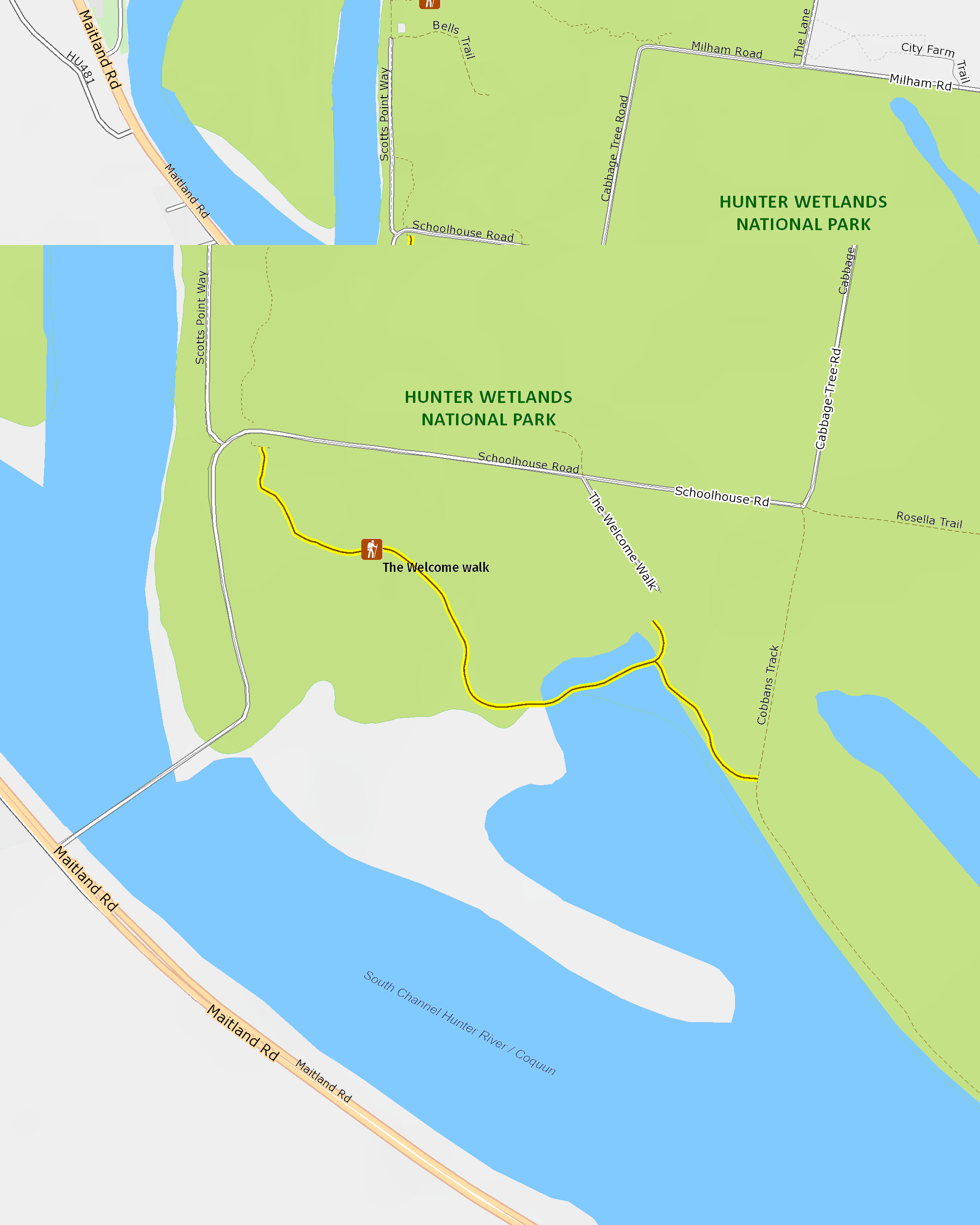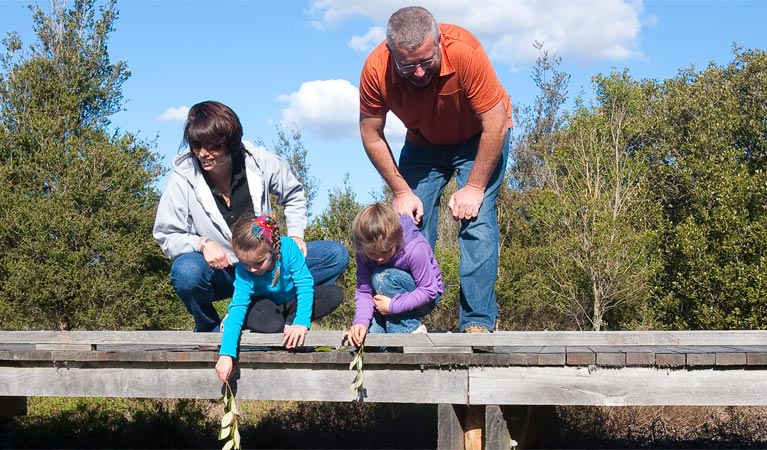The Welcome walk
Hunter Wetlands National Park
Overview
One of the great short walks of the Hunter region, The Welcome Walk takes you through the Hunter River estuary and is great for birdwatching or walking with children.
- Where
- Hunter Wetlands National Park in North Coast
- Accessibility
- Easy
- Distance
- 1km one-way
- Time suggested
- 20 - 40min
- Grade
- Grade 2
- Opening times
- The Welcome walk is always open but may have to close at times due to poor weather or fire danger.
- What to
bring - Sunscreen, hat, drinking water
- Please note
- Remember to take your binoculars if you want to birdwatch.
- This walk takes you to the Schoolmasters House, which today is used as a base for the Kooragang Wetland Rehabilitation Project (KWRP). The KWRP undertakes conservation projects in the Hunter estuary and has an extensive volunteer program.
Did you know mangroves are excellent fish nurseries? That there is a plant called sea celery? Or that saltmarsh is classified as an Endangered Ecological Community? You can learn all about these issues and more on The Welcome walk in Hunter Wetlands National Park. Walking along the raised boardwalk, you’ll meander above the saltwater wetlands of the Hunter River estuary, maybe spotting a fish or two or crabs.
This short walk is ideal for walking with children. You can set your own gentle pace, peeking and pointing at the wildlife and exploring the intricate world beneath you. Birdwatch as you go – there will be plenty of water birds about – and check out the interesting grasses and aquatic plants within the saltmarsh ecosystem.
You’re bound to get some great photos any time you visit, but many say this walk is at its best in spring, when delicate cream-coloured flowers adorn the mangroves.
Take a virtual tour of The Welcome walk captured with Google Street View Trekker.
Map

Map legend

Local alerts
For the latest updates on fires, closures and other alerts in this area, see https://www.nationalparks.nsw.gov.au/things-to-do/walking-tracks/the-welcome-walk/local-alerts
General enquiries
- National Parks Contact Centre
- 7am to 7pm daily
- 1300 072 757 (13000 PARKS) for the cost of a local call within Australia excluding mobiles
- parks.info@environment.nsw.gov.au
Park info
- in Hunter Wetlands National Park in the North Coast region
Hunter Wetlands National Park is always open but may have to close at times due to poor weather or fire danger.
Visitor info
All the practical information you need to know about The Welcome walk.
Maps and downloads
Learn more
The Welcome walk is in Hunter Wetlands National Park. Here are just some of the reasons why this park is special:
All-ages adventure

The action all starts at Riverside Park. Here, you'll find a picnic area and paths leading off around Ash Island. They're all flat and wide, so perfect for getting kids on their bikes for some fresh air. Take a walk through the wetlands and identify different species of birds. Head to the deepwater jetty and do some fishing. There's quite the underwater bounty around here and, whether your spot is the jetty or the river foreshores, you can haul in flathead, whiting, tailor and bream.
- Rainforest walk to Riverside Park Rainforest walk to Riverside Park, near Newcastle, is suitable for walking or cycling and crosses Ash Island, ending by the river where you can fish and birdwatch.
- Riverside Park The family-friendly Riverside Park, near Newcastle, is the perfect base for cycling, walking, fishing and birdwatching on Ash Island.
- Scotts Point Way to Riverside Park trail Enjoy an easy walk or bike ride along the river on the Scott Point to Riverside Park trail, Ash Island, as it takes you past excellent spots for fishing and birdwatching.
Early evidence

Get a taste of some of the area's history. From the picnic area at Riverside Park, you can walk through the Kooragang City Farm precinct and find the ruins of the farmhouse and dairy built by William Milham, who ran a property here with the first European owner of Ash Island, AW Scott. Also on the island is a heritage-listed World War II radar 'igloo'.
- Rainforest walk to Riverside Park Rainforest walk to Riverside Park, near Newcastle, is suitable for walking or cycling and crosses Ash Island, ending by the river where you can fish and birdwatch.
- Scotts Point Way to Riverside Park trail Enjoy an easy walk or bike ride along the river on the Scott Point to Riverside Park trail, Ash Island, as it takes you past excellent spots for fishing and birdwatching.
Feather bluster

The Hunter River and its estuaries are home to a number of habitats - freshwater wetlands, mangroves and coastal rainforest among them - making the area a haven for birdlife. More than 200 species of birds live here or pass through on their migration. Head to Stockton Sandspit, where shorebirds - plovers, oystercatchers and curlews, to name a few - roost and feed on the mud flats. Along the river foreshore, you'll also likely see pelicans, spoonbills, black swans and, sweeping over the water searching for fish, sea eagles and swamp harriers.
- Guided kayak adventures at Smiths Island Spend a day exploring mangrove forests and islands by kayak on this tour of Hunter Wetlands National Park with the friendly guides from the School of Yak. It’s a great way to reconnect with nature in this birdwatchers’ paradise around Smiths Island.
- Junior ranger: Shorebirds and mangroves Calling all junior rangers, join us on a birdwatching adventure these school holidays! Bring your camera and see if you can photograph the shorebirds at Hunter Wetlands National Park, near Newcastle.
- The Earth's environment Did you know that over 10 per cent of NSW is a national park? That’s over 7 million hectares. This Stage 2 (Years 3-4) Geography excursion is delivered Hunter Wetlands National Park.
World-class wetlands

Hunter Wetlands National Park makes up part of the Hunter Estuary Wetlands Ramsar site (the Ramsar convention recognises wetlands of international importance). This peaceful area is important for many species of birds, including 45 that migrate internationally. The green and golden bell frogs, both threatened species, breed in the freshwater lagoons. The mangroves here also provide maternity roosts for tiny bats, including the eastern free-tail bat.
- Junior ranger: Shorebirds and mangroves Calling all junior rangers, join us on a birdwatching adventure these school holidays! Bring your camera and see if you can photograph the shorebirds at Hunter Wetlands National Park, near Newcastle.
- Rainforest walk to Riverside Park Rainforest walk to Riverside Park, near Newcastle, is suitable for walking or cycling and crosses Ash Island, ending by the river where you can fish and birdwatch.
- Riverside Park The family-friendly Riverside Park, near Newcastle, is the perfect base for cycling, walking, fishing and birdwatching on Ash Island.
Plants and animals protected in this park
Animals
-

Grey-headed flying-fox (Pteropus poliocephalus)
The grey-headed flying fox is Australia's largest native bat, with a wingspan up to 1m. This threatened species travels up and down south-eastern Australia and plays a vital role in pollinating plants and spreading seeds in our native forests.
-

Green and golden bell frog (Litoria aurea)
The green and golden bell frog is an endangered Australian frog. Once common on the NSW coast and tablelands, populations have plummeted around 90 percent.
Plants
-

Grey mangrove (Avicennia marina)
Grey mangrove is the most common and widespread mangrove found within intertidal zones across Australia, and throughout the world. Growing to a height of 3-10m, they thrive best in estuaries with a mix of fresh and salt water. They excrete excess salt through their long thick leaves, and absorb oxygen through their aerial root system.

